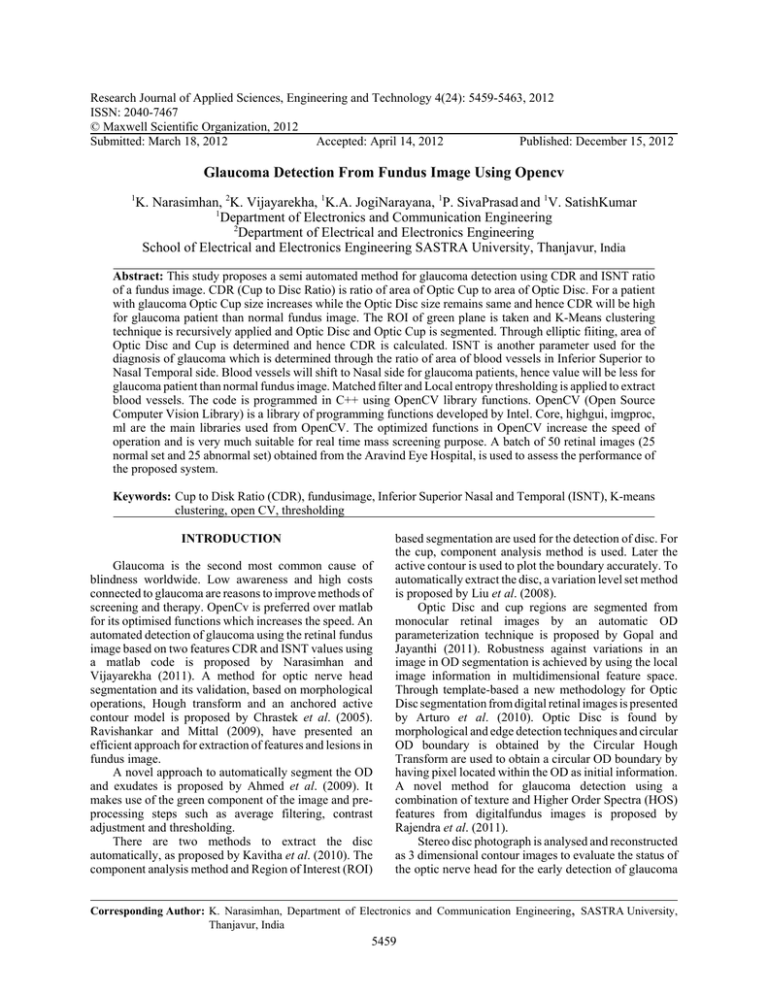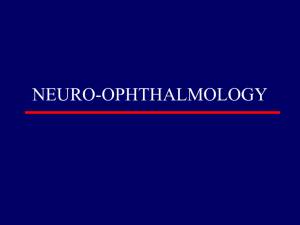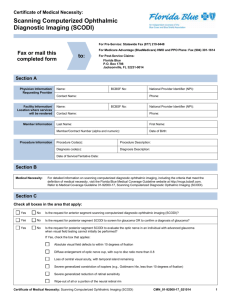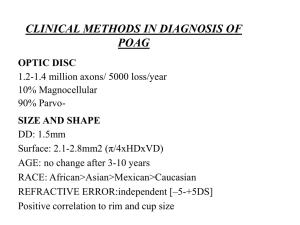Research Journal of Applied Sciences, Engineering and Technology 4(24): 5459-5463,... ISSN: 2040-7467
advertisement

Research Journal of Applied Sciences, Engineering and Technology 4(24): 5459-5463, 2012 ISSN: 2040-7467 © Maxwell Scientific Organization, 2012 Submitted: March 18, 2012 Accepted: April 14, 2012 Published: December 15, 2012 Glaucoma Detection From Fundus Image Using Opencv 1 K. Narasimhan, 2K. Vijayarekha, 1K.A. JogiNarayana, 1P. SivaPrasad and 1V. SatishKumar 1 Department of Electronics and Communication Engineering 2 Department of Electrical and Electronics Engineering School of Electrical and Electronics Engineering SASTRA University, Thanjavur, India Abstract: This study proposes a semi automated method for glaucoma detection using CDR and ISNT ratio of a fundus image. CDR (Cup to Disc Ratio) is ratio of area of Optic Cup to area of Optic Disc. For a patient with glaucoma Optic Cup size increases while the Optic Disc size remains same and hence CDR will be high for glaucoma patient than normal fundus image. The ROI of green plane is taken and K-Means clustering technique is recursively applied and Optic Disc and Optic Cup is segmented. Through elliptic fiiting, area of Optic Disc and Cup is determined and hence CDR is calculated. ISNT is another parameter used for the diagnosis of glaucoma which is determined through the ratio of area of blood vessels in Inferior Superior to Nasal Temporal side. Blood vessels will shift to Nasal side for glaucoma patients, hence value will be less for glaucoma patient than normal fundus image. Matched filter and Local entropy thresholding is applied to extract blood vessels. The code is programmed in C++ using OpenCV library functions. OpenCV (Open Source Computer Vision Library) is a library of programming functions developed by Intel. Core, highgui, imgproc, ml are the main libraries used from OpenCV. The optimized functions in OpenCV increase the speed of operation and is very much suitable for real time mass screening purpose. A batch of 50 retinal images (25 normal set and 25 abnormal set) obtained from the Aravind Eye Hospital, is used to assess the performance of the proposed system. Keywords: Cup to Disk Ratio (CDR), fundusimage, Inferior Superior Nasal and Temporal (ISNT), K-means clustering, open CV, thresholding INTRODUCTION Glaucoma is the second most common cause of blindness worldwide. Low awareness and high costs connected to glaucoma are reasons to improve methods of screening and therapy. OpenCv is preferred over matlab for its optimised functions which increases the speed. An automated detection of glaucoma using the retinal fundus image based on two features CDR and ISNT values using a matlab code is proposed by Narasimhan and Vijayarekha (2011). A method for optic nerve head segmentation and its validation, based on morphological operations, Hough transform and an anchored active contour model is proposed by Chrastek et al. (2005). Ravishankar and Mittal (2009), have presented an efficient approach for extraction of features and lesions in fundus image. A novel approach to automatically segment the OD and exudates is proposed by Ahmed et al. (2009). It makes use of the green component of the image and preprocessing steps such as average filtering, contrast adjustment and thresholding. There are two methods to extract the disc automatically, as proposed by Kavitha et al. (2010). The component analysis method and Region of Interest (ROI) based segmentation are used for the detection of disc. For the cup, component analysis method is used. Later the active contour is used to plot the boundary accurately. To automatically extract the disc, a variation level set method is proposed by Liu et al. (2008). Optic Disc and cup regions are segmented from monocular retinal images by an automatic OD parameterization technique is proposed by Gopal and Jayanthi (2011). Robustness against variations in an image in OD segmentation is achieved by using the local image information in multidimensional feature space. Through template-based a new methodology for Optic Disc segmentation from digital retinal images is presented by Arturo et al. (2010). Optic Disc is found by morphological and edge detection techniques and circular OD boundary is obtained by the Circular Hough Transform are used to obtain a circular OD boundary by having pixel located within the OD as initial information. A novel method for glaucoma detection using a combination of texture and Higher Order Spectra (HOS) features from digitalfundus images is proposed by Rajendra et al. (2011). Stereo disc photograph is analysed and reconstructed as 3 dimensional contour images to evaluate the status of the optic nerve head for the early detection of glaucoma Corresponding Author: K. Narasimhan, Department of Electronics and Communication Engineering, SASTRA University, Thanjavur, India 5459 Res. J. Appl. Sci. Eng. Technol., 4(24): 5459-5463, 2012 and the evaluation of the efficacy of treatment is presented by Kong et al. (2004). To detect the edge of the optic nerve head and retinal vessels and to reduce noises, stepwise pre-processingis introduced. RetCam is a new imaging modality that captures the image of iridocorneal angle for the classification is presented by Jun et al. (2004). Glaucoma is the one of the two major causes of blindness, which can be diagnosed through measurement of neuro-retinal CDR is described by Zhuo et al. (2009). Automatic calculation of optic cup boundary is challenging due to the interweavement of blood vessels with the surrounding tissues around the cup. A multimodality fusion approach for neuro retinal cupdetection improves the accuracy of the boundary estimation. Modeling of Scanning Laser polarimetry method is presented by Koen et al. (2006) to model the change in images acquired by scanning laser polarimetry for the detection of glaucomatous progression. The Optic Disc is the exit point of retinal nerve fibers from the eye and the entrance and exit point for retinal blood vessels. A new filtering approach in the wavelet domain for image pre-processing is described by Vahabi et al. (2010). Sobel edge detection, Texture Analysis, Intensity and Template matching techniques are used to detect Optic Disc. The objective of the proposed system is to detect glaucoma by extracting the two features CD Ratio and ISNT Ratio from the fundus image using OpenCV. This study can be automated by using standard classifier and hardware can be developed by dumping the code into a processor which supports OpenCV. MATERIALS AND METHODS C C C C A batch of 50 retinal images (25 normal set and 25 abnormal set) obtained from the Aravind Eye Hospital, Madurai, Tamilnadu, India during October, 2011 is used to assess the performance of the proposed system OpenCv (Open Source Computer Vision Library), Version 2.2 Microsoft Visual C++, 2008 Express Edition Highgui, cxcore are the libraries used Fig. 1: ROI extraction stage (a) (b) (c) Fig. 2: (a) Fundus image, (b) green channel, (c) ROI image The optic disc is the entrance of the vessels and the optic nerve into the retina. In fundus images, the optic disc belongs to the brightest point of the image as mentioned by (Walter and Klein, 2005). Hence the maximum brightest point within the optic disc in the G plane is determined using cvMinMaxLoc(). The approximate region around the identified brightest point is to be selected for initial optic disc region as ROI. As it takes more time to process an image of larger size, a square of size 360×360 pixels with the brightest pixel as the centre point is decided to consider as ROI. The initial ROI covers mainly the entire optic disc along with a small portion of other regions of the image. Figure 2 shows the images in ROI extraction stage. Proposed methodology: The proposed system mainly consists of three different stages. They are Region of Interest (ROI) Extraction, CDR Calculation and ISNT Calculation. All the stages are explained in detail in the following sub sections. CDR calculation: The Optic disc and cup are extracted from the ROI by using the K-Means clustering technique. Both optic disc and cup are fitted into elliptical shapes to find the area. This can be explained in the sections below. ROI extraction: The ROI Extraction stage is shown in Fig. 1. The retinal images have been taken by fundus camera in RGB mode. The size of the fundus image is 1504x1000 pixels. G plane is considered for theextraction of optic disc and optic cup, as it provides better contrast than the other two planes. Hence it is necessary to separate the G plane for further analysis. Feature extraction: K-means clustering plays a vital role in the feature extraction stage to compute one of the features CDR. It is an unsupervised learning algorithm that solves the well-known clustering problem. The procedure follows a simple and easy way to classify a given data set through a certain number of clusters (k clusters) fixed a priori. The function cvKMeans2() 5460 Res. J. Appl. Sci. Eng. Technol., 4(24): 5459-5463, 2012 (a) (b) (c) Fig. 3: (a) K means clustering image, (b) optic disc, (c) optic cup implements a k-means algorithm that finds the centres of n clusters and groups the input samples around the clustersis to define k centroids, one for each cluster. At this point k new centroids are calculated as the mean of the clusters resulting from the previous step. As aresult of repetitive application of these two steps, the k centroids change their location step by step until no more changes take place. Localizing optic disc and optic cup: The K-means algorithm is an iterative technique that is used to partition the ROI image into K clusters. The ROI covers mainly the entire optic disc, optic cup and a small portion of other regions of the image. Hence the K value is chosen as 3. From the three clusters as shown in Fig. 3a, the optic disc cluster has to be identified as follows. The cluster which contains the border region belongs to the other region of the ROI image that does not contain the optic disc and optic cup. Hence, the cluster is removed for the extraction of optic disc and the remaining two clusters form the optic disk region which is shown in Fig. 3b. Since it is clearly known that the optic cup is inside the optic disc, the cluster in the center of the image forms the optic cup which is shown in Fig. 3c. Finally, the morphological operation is performed to fill the holes and small region inside optic disc cluster and optic cup cluster. After extracting optic disc, contours are found and the contour with maximum area will correspond to the optic disc. cvMinAreaRect2() is used to draw an ellipse that is inscribed in the rectangle. The area of the ellipse as well as the area of the optic disc is calculated by using the formula A = Bab where a and b are major axis length (half of the rectangle width) and minor axis length (half of the rectangle height), respectively. The area of optic cupis (a) (b) (a) (b) Fig. 4: (a) ROI, (b) matched filter response, (c) after local entropy thresholding (d) blood vessels in optic disc also computed in the same manner. The CDR which is the ratio between the area of the optic cup and the area of the optic disc is computed and used as one of the features for the detection of glaucoma. ISNT calculation: The ISNT ratio is calculated by measuring the area of blood vessels in the four quadrants superior, inferior, nasal and temporal. The blood vessels are enhanced by applying a matched filter response. By local entropy thresholding technique blood vessels are extracted and area of blood vessels is calculated in all four quadrants. Matched filter: The piecewise linear segments of blood vessels in the ROI image is enhanced using the concept of matched filter. Blood vessels which have poor contrast are enhanced by convolving the designed matched filter kernel with the original image. A prototype kernel can be expressed as: x2 L f x , y exp 2 , for y 2 2 where, L is the length of the segment for which the vessel is assumed to have a fixed orientation. A set of twelve 15×16 pixel kernel is applied by convolving to a fundus image. The maximum response is taken at each pixel. cv2DRotationMatrix and cvWarpAffine are the functions used to rotate the kernel. The blood vessels in a retinal image and the enhanced image are shown (Fig. 4). Local entropy thresholding: The obtained matched filter response is processed by proper thesholding to extract the 5461 Res. J. Appl. Sci. Eng. Technol., 4(24): 5459-5463, 2012 (a) (b) (c) (d) (a) (b) (c) (d) Fig. 5: Masks used in the proposed system and the blood vessels inside the mask, (a)inferior side, (b) temporal side, (c) superior side, (d) nasal side blood vessels from the background. The co-occurrence matrix of the matched filter response is calculated, threshold value is calculated using the method proposed by (Thitiporn and Guoliang, 2003). Thresholding is done using the obtained threshold. A circular mask is constructed to extract the blood vessels from the optic disc only. The blood vessels in the four quadrants are obtained by rotating a mask image of size 360×360, the size of the ROI image. The area of blood vessels in each quadrant is calculated and there by the ISNT ratio is obtained. The obtained blood vessels corresponding to the mask are shown (Fig. 5) EXPERIMENTAL RESULTS CDR and ISNT ratio values obtained for a set of 5 images using OpenCV for both Normal and Glaucoma images are shown in a tabular column below. CDR is high for glaucoma patients due to increase in cup size and ISNT ratio is less for glaucoma patients because blood vessel will shift more towards the nasal side. From the Table 1 we can conclude that the threshold value for CDR can be set at 0.33 and for ISNT ratio threshold can be set at approximately 1.00. Table 1: Threshold values for CDR and ISNT CDR ISNT ratio ----------------------------------------------------------------------Normal Glaucoma Normal Glaucoma 0.251677 0.438216 1.49339 0.888331 0.264667 0.478355 1.39850 0.792978 0.248185 0.411433 1.28383 0.863016 0.290834 0.489845 1.33410 0.882103 0.314159 0.460059 1.38615 0.887684 CONCLUSION In this study, a method for detection of glaucoma based on the two features CDR and ISNT ratio is presented. The optic disc and optic cup from the ROI image is extracted by recursively applying K-Means clustering and the area is calculated using elliptical fitting technique. Blood vessels are enhanced using matched filter response and are extracted using local entropy thresholding technique.Blood vessels in each quadrant are extracted by running a mask and the area is calculated and there by ISNT ratio is obtained. The code programmed in OpenCv can be implemented easily in hardware. The performance of the proposed system can be increased by using classifier.Experimental results shows that a sensitivity of 90% is obtained from the predefined set of images. REFERENCES Ahmed, W.R., C. Eswaran and H. Subhas, 2009. Automatic tracing of optic disc and exudates from color fundus images using fixed and variable thresholds. J. Med. Syst., 33(1): 73-80, DOI: 10.1007/s10916-008-9166-4. Arturo, A., M.E. Gegundez-Arias and M. Diego, 2010. Detecting the optic disc boundary in digital fundus images using morphological, edge detection and feature extraction techniques. IEEE Trans. Med. Imaging, 29(11): 1860-1869. Chrastek, R., M. Wolf and K. Donath, 2005. Automated segmentation of the optic nerve head for diagnosis of glaucoma. Med. Image Anal., 9(4): 297-314. 5462 Res. J. Appl. Sci. Eng. Technol., 4(24): 5459-5463, 2012 Gopal, D.J. and S. Jayanthi, 2011. Optic disk and cup segmentation from monocular color retinal images for glaucoma assessment. IEEE Trans. Med. Imaging, 30(6): 1192-205. Jun, C., L. Jiang and H.L. Beng, 2004. Closed angle glaucoma detection in retcamimages. IEEE Proceedings of the 32nd Annual International Conference, pp: 4096-4099. Kavitha, S., S. Karthikeyan and K. Duraiswamy, 2010. Early detection of glaucoma in retinal images using cup to disc ratio. IEEE 2nd International Conference on Computing, Communication and Networking Technologies, pp: 1-5. Koen A. Vermeer, Frans M. Vos, Barrick Lo, 2006. Modeling of scanning laser polarimetry images of the human retina for progression detection of glaucoma. IEEE Trans. Med. Imaging, 25(5): 517-528. Kong, H.J., S.K. Kim and J.M. Seo, 2004. Three dimensional reconstruction of conventional stereo optic disc image. IEEE Proceedings of the 26th Annual International Conference, pp: 1229-1232. Liu, J., D.W.K. Wong, J.H. Lim and X. Jia, 2008. Optic cup and disk extraction from retinal fundus images for determination of cup-to-disc ratio. IEEE 3rd Conference on Industrial Electronics and Applications, pp: 1828-1832. Narasimhan, K. and K. Vijayarekha, 2011. An efficient automated system for glaucoma detection using fundus image. J. Theoret. Appl. Inform. Techn., 33(1): 104-110. Rajendra, U.A., D. Sumeet and D. Xian, 2011. Automated diagnosis of glaucoma using texture and higher order spectra features. IEEE Trans. Inf. Technol. Biomed., 15(3): 449-455. Ravishankar, S.J. and A. Mittal, 2009. Automatedfeature extraction for early detection of diabetic retinopathy in fundus images. IEEE Conference on Computer Vision and Pattern Recognition, pp: 210-217. Thitiporn, C. and F. Guoliang, 2003. An efficient blood vessel detection algorithm for retinal images using local entropy thresholding. IEEE Proceedings of the International Symposium on Circuits and Systems, pp: 21-24. Vahabi, Z., M. Vafadoost and S. Gharibzadeh, 2010. The new approach to Automatic detection of Optic Disc from non-dilated retinal images. IEEE Proceedings of the 17th Iranian Conference of Biomedical Engineering, pp: 1-6. Walter, T. and J.C. Klein, 2005. Automatic analysis of color fundus photographs and its application to the diagnosis of diabetic retinopathy. Handbook Biomed. Image Anal., 2: 315-368. Zhuo, Z., L. Jiang and K.W. Wing, 2009. Neuro-retinal optic cup detection in glaucoma diagnosis. IEEE Proceedings of the 2nd International Conference on Biomedical Engineering and Informatics, pp: 1-4. 5463






